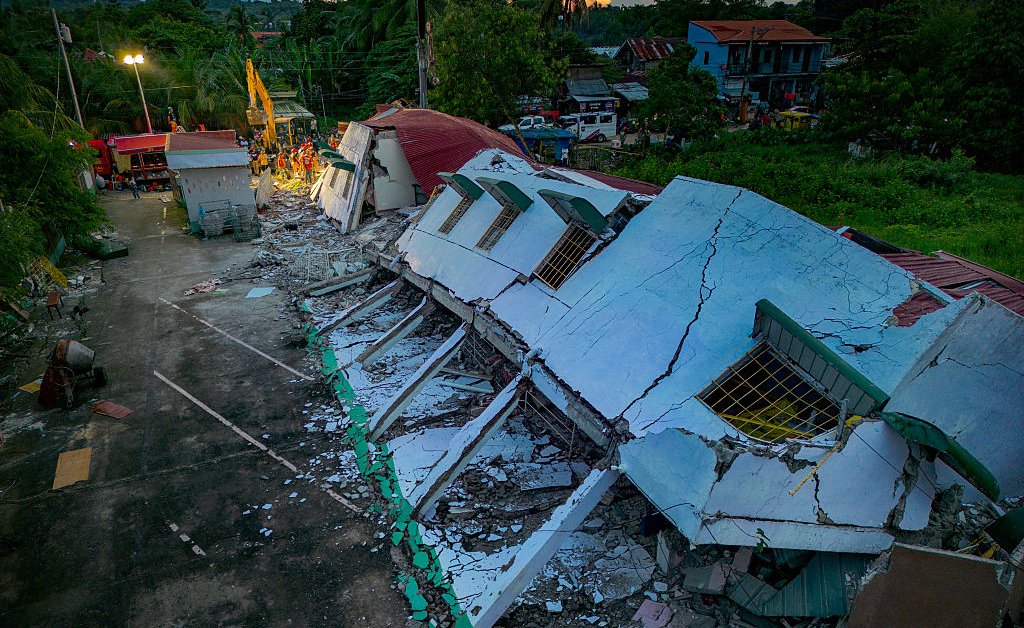The Philippines is no stranger to earthquakes—it sits on the seismically active Pacific Ring of Fire. But a temblor which struck on Tuesday, Sept. 30, became the deadliest the country has ever experienced since at least 2013.
A 6.9-magnitude quake hit just before 10 p.m. local time (10 a.m. ET), Philippine seismologists reported, off the shore of coastal Bogo City (pop. 90,000) in the island province of Cebu in the archipelagic Southeast Asian country’s center.
The quake’s epicenter was shallow, only some 5 km below the surface, which means its energy needed to travel less distance before hitting infrastructure. The seismic energy was strong enough to cause buildings to collapse—including a century-old church—and to leave cracks on bridges. In one affected town, the quake led to part of a sports complex collapsing on spectators of a basketball game. In Bogo City, a village reported some 10 casualties, despite being made up of “disaster resilient homes” that housed survivors of a devastating supertyphoon back in 2013.
A tsunami alert was issued for several Philippine regions, though that has since been lifted as of Thursday.
National disaster officials reported at least 72 people died and 294 were injured after the quake, though the official toll could increase in the coming days.
Civil defense official Bernardo Rafaelito Alejandro IV told a news conference from Manila on Wednesday that the country was “still in the golden hour of our search and rescue,” adding that there “are still many reports of people who were pinned or hit by debris.” By Thursday afternoon, the national police said all missing individuals had been accounted for.
Alejandro added that the quake was particularly deadly because it happened at night. “In the morning, we are all alert, but at night when everyone is asleep, it takes time for us to react.”
A state of calamity was issued over the province on Wednesday, and on Thursday, President Ferdinand “Bongbong” Marcos Jr. visited hard-hit areas to assess the extent of the damage.
Here’s what to know.
Battered by natural disasters
Tuesday’s quake is the deadliest the country has experienced since October 2013, when more than 200 people died in the Philippines’ central region after a 7.2-magnitude quake struck the neighboring island of Bohol.
Besides being a hotbed of seismic activity, the Philippines is also among the most climate-vulnerable countries globally, seeing more than 20 typhoons and tropical storm systems yearly.
The Cebu quake also happened after a tropical storm late last week battered Cebu and other provinces in the country’s central region. That storm separately left at least 27 people dead—many knocked down by felled trees or drowned—and cut power to cities and towns and forced thousands of people to evacuate their homes. It also increased the risk of landslides after heavy rains soaked hillsides and softened soil.
The quake and the storm combined caused widespread power outages, affecting hospitals and first responders’ ability to attend to victims.
Latest figures from national disaster officials show that more than 170,000 people were affected by the quake, and 20,000 have been displaced.
A ‘Big One’ in Manila?
The latest quake in the central region has raised fears of a major temblor happening in the capital Manila, which many have ominously nicknamed the “Big One.”
A fault system in the metropolitan Manila region has recorded seismic activity that could reach up to a magnitude 7.2. Such quakes in this fault system happen every 200 to 400 years, and the last recorded tremor from the area was in the 1600s.
Such a sizable quake could cause some 168,000 buildings to collapse and more than 33,000 people to die in Manila and neighboring provinces.
Alejandro said lessons from the Cebu earthquake should be applied when the “Big One” strikes the capital. “We can never be 100% prepared,” he said. “Events like this [earthquake], for us also, is one way of practice. Can you imagine if it happens in Metro Manila at night?”
The post Why the Latest Earthquake in the Philippines Was Particularly Deadly appeared first on TIME.




